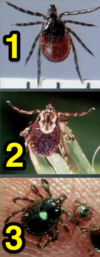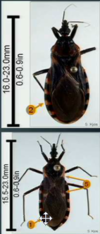Microbiology-Insect Vectors Flashcards
(23 cards)
Vector commonly associated with mechanical transmission
House fly. It picks up pathogens on feet, hair etc and transfers it.
3 forms of biological transmission
1) Propagative: pathogen multiplies in vector (arboviruses) 2) Cyclo-Developmental: pathogen changes forms in vector (filariasis) 3) Cyclo-propagative: pathogen changes form and multiplies in vector (malaria, leishmaniasis)
2 most important arthropods
Hexapoda: insects and Arachnida: ticks and mites.
What is a chigger? How does it cause skin irritation?
A mite. It causes harm via secretion of digestive enzymes in saliva of larvae. This is what forms the hole in your skin (stylostome)
What disease do chiggers transmit?
Scrub typhus (caused by orienta tsutsugamushi, an obligate intracellular gram - bacteria, which is present in the salivary glands of chigger larvae)
A patient presents with headache, fever, anorexia and malaise. He is from south Texas and has a number of bites on his legs that are dark and necrotic in the center. What is causing his condition?
This is likely scrub typhus from chigger transmission of o. tsutsugamushi.
Mite present in 90-100% of old people? Disease association?
Follicle mite, associated with skin eruption.
What disease are each of these ticks associated with?

1) Black-legged tick (Ixodes scapularis) 2) American dog tick (Dermacentor variabilis) 3) Lone star tick (Amblyomma americanum)
Black-legged tick life cycle
Eggs hatch into larvae during the summer -> larvae feed on rodents in summer, drop off over winter -> molt to nymphs the following spring -> latch on again in spring -> drop off and molt to adults in the fall -> adults seek larger animals. It is a 3 host tick.
Why do people rarely get lyme disease if the tick is removed within 48 hours?
It needs to secrete anti-coagulant enzymes before it can suck blood and transmit pathogens from its saliva. This takes about 48 hours.
Disease significantly increased by cockroaches
Allergic asthma in children (German cockroaches produce most allergens). They also carry many other microorganisms.
A patient presents with dysphagia and says that he feels like food gets stuck when he eats. CXR shows a bird beak appearance. What is the vector for this condition?
Kissing bugs from the rediviidae family transmit American trypanosomiasis, which causes Chagas disease. The bug bites you, poops on the bite and then rubs it in and thats how you get the parasite. It is also thought that bed bugs (triatomine) can transmit it. Note that the parasite undergoes cyclopropagative development in these vectors.

A patient presents with intermittent fever, headaches, joint pains and itching. Physical exam reveals swollen lymph nodes along the back of the neck and a chancre on the arm. A few weeks later the patient becomes anemic, sleeps in the day, is awake at night, has tremors and paralysis. What transmits this infection?
The tsetse fly causes African trypanosomiasis (by transmitting the parasite T. brucei). The parasite undergoes cyclopropagative development in the gut of the fly.

What mosquito transmits West Nile, St. Louis encephalitis, WEE, VEE, Japanese encephalitis, Ross River virus and Bancroftian filariasis? How can you identify this mosquito?

Culex. They lay eggs in rafts and have long respiratory siphons.
What mosquito transmits Dengue, Yellow fever, California group viruses and Bancroftian filariasis? How can you identify this mosquito?

Aedes. They breed in temporary pools and containers by laying single eggs, they also have a respiratory tube.
What mosquito transmits malaria, Bancroftian filariasis, Brugian filariasis and arbovirues? How can you recognize them?

Anopheles. They eat at a 45 degree angle, have 3 long stillettes where it feeds, do not have a respiratory tube and consequently rest on top of the water.
A patient presents with river blindness. What is the vector for this condition?
Hump-backed black flies. Their larvae are found in fast moving water and carry onchocerciasis.
What are the vectors of leishmaniasis and bartonellosis?

Sand flies.
What is the vector that can mechanically transmit polio, hepatitis, guard, yaw, salmonella, entamoeba, E. coli, helminths and fungi?
Filth flies, they breed in filthy habitats.
Pediculus humanus capitis vs humanus? Why is the distinction between the two important?
Capitis = head louse. Humanus = body louse. Only the body louse are responsible for transmitting pathogens.
Vector of epidemic typhus (Rickettsia prowazekii), relapsing fever (borrelia recurrentis) and trench fever (bartonella quintana)?
Pediculus humanus humanus (body louse). They transmit disease through their feces.
What happens to the louse in epidemic typhus?
Rickettsia prowazekii is fatal to the louse.
Vectors of plaque, murine typhus and tape worms that are also mechanical vectors of tularemia?
Fleas. Xenopsylla cheopis is a vector of plague and murine typhus.


